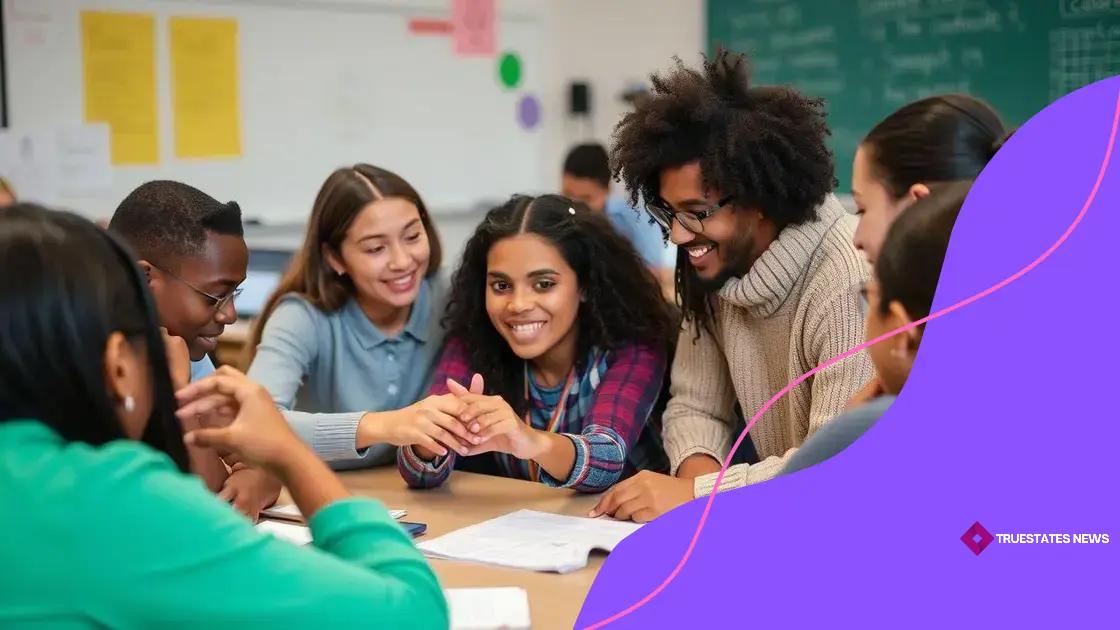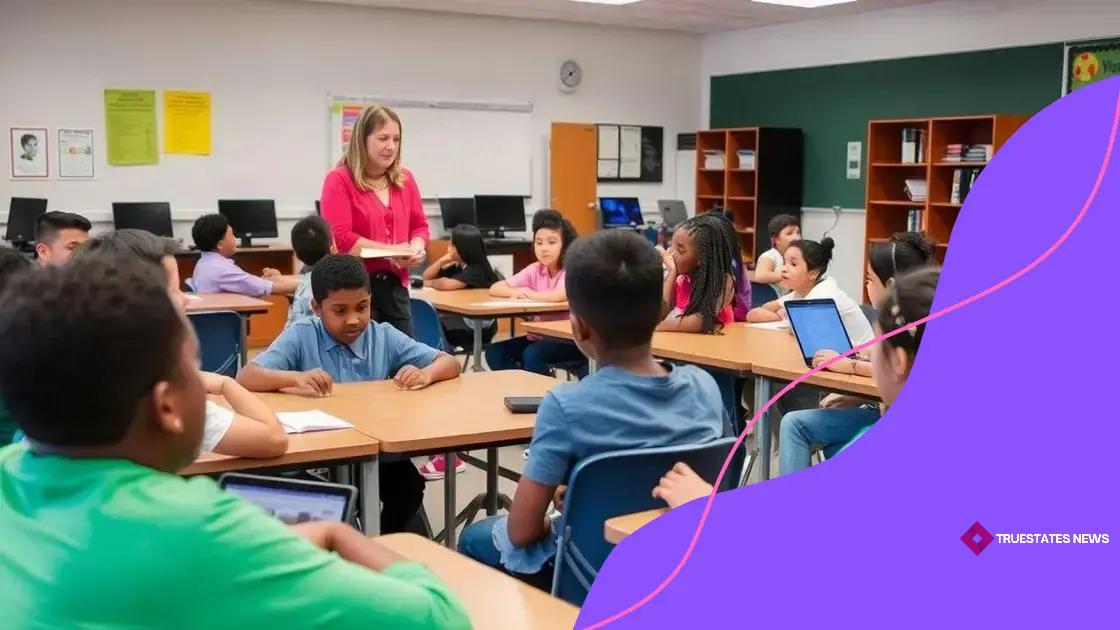Inclusive teaching methods for diverse classrooms

Inclusive teaching methods focus on adapting educational practices to meet the diverse needs of all students, fostering a supportive environment that enhances learning and engagement for everyone.
Inclusive teaching methods help cater to the diverse needs of students, ensuring everyone has a voice. Ever wondered how these strategies create a better learning environment for all? Let’s delve into the ways to make education accessible and engaging for everyone.
Understanding inclusive teaching methods
Understanding inclusive teaching methods is crucial for creating a supportive learning environment. These methods aim to meet the diverse needs of all students, helping them to thrive together.
Teachers can facilitate this inclusivity through various approaches. One effective strategy is recognizing the different learning styles among students. By addressing these variations, educators can help children grasp concepts more easily.
Diverse Learning Styles
Every student has a unique way of learning. Incorporating different resources can enrich the educational experience.
- Visual aids like charts and graphs assist visual learners.
- Group discussions engage auditory learners.
- Hands-on activities support kinesthetic learners.
Another key aspect involves building a respectful classroom culture. When students feel valued, they are more likely to participate and share their ideas.
Building a Respectful Culture
Creating this environment requires attention to student interactions.
- Encourage teamwork through group projects.
- Promote empathy by discussing diverse perspectives.
- Celebrate each student’s achievements, big or small.
Furthermore, adapting lesson plans to include various perspectives can foster a sense of belonging. Teachers might incorporate resources from different cultures to engage students meaningfully.
Adapting Content for Inclusion
This adaptation can be as simple as including multicultural authors or discussing global issues. Such practices not only broaden student horizons but also validate their backgrounds.
Using inclusive teaching methods ultimately prepares students for a diverse world. By providing the right tools and environment, educators can empower every learner to succeed.
Benefits of inclusive teaching strategies
The benefits of inclusive teaching strategies extend beyond just meeting diverse needs. They create an environment where all students feel valued and engaged in their learning.
When educators employ these strategies, they foster a culture of respect and collaboration. This approach not only enhances understanding but also promotes social skills among students.
Enhanced Learning Experiences
Inclusive teaching methods cater to various learning styles, allowing each student to grasp information in a way that suits them best.
- Visual aids help students who learn better with images.
- Group discussions engage those who thrive in social settings.
- Hands-on activities benefit kinesthetic learners.
Moreover, by integrating multiple perspectives into lessons, educators encourage critical thinking. Students become more open-minded as they learn to appreciate differences.
Building Social Skills
In an inclusive classroom, students interact frequently with peers from different backgrounds. This engagement helps them develop important social skills.
- Teamwork is emphasized during group projects.
- Students learn empathy by understanding various perspectives.
- Engaging with diverse classmates fosters friendships and respect.
Additionally, inclusive teaching strategies often lead to improved academic performance. When students feel supported, they are more likely to succeed in their studies.
Moreover, these methods cultivate a sense of belonging. Students recognize that their contributions matter, which boosts their confidence and motivation.
Utilizing inclusive teaching strategies enables educators to create a nurturing and effective learning environment. This ultimately benefits everyone involved, as all students gain the skills necessary to thrive in a diverse world.
Practical tips for implementing inclusion

Implementing inclusion in the classroom requires thoughtful planning and action. Using practical tips for implementing inclusion can help create an environment where every student feels valued and has the opportunity to succeed.
One effective method is to start by assessing the needs of your students. Understanding their unique challenges allows you to tailor your teaching approach accordingly. This assessment can be done through observations, surveys, or discussions with students and their families.
Assessing Student Needs
Knowing the specific needs of each student can guide how you implement inclusion.
- Identify students with different learning preferences.
- Recognize any physical or emotional challenges they may have.
- Engage with parents to gain insights on their children’s needs.
It’s also essential to create a flexible classroom environment. This flexibility allows for adjustments based on students’ responses and learning styles. For instance, arranging seating to facilitate group work can foster collaboration.
Creating a Flexible Environment
A flexible environment encourages participation from all students.
- Use movable furniture to adapt the space easily.
- Provide various materials to support different learning methods.
- Establish clear routines to create stability.
In addition, utilizing technology can enhance inclusivity. Online tools and resources help cater to varying learning styles and paces. Integrating assistive technology for students with disabilities makes learning more accessible.
Effective communication is also vital. Encourage open dialogues with students about their experiences in class. Create an environment where they feel comfortable sharing their thoughts and feelings.
By implementing these practical tips for inclusion, educators can make a significant impact on the classroom experience, ensuring every student has a chance to thrive.
Assessing student needs in an inclusive setting
Assessing student needs in an inclusive setting is essential for creating effective learning experiences. By understanding each student’s unique needs, teachers can tailor their instruction to support learning for everyone.
To begin, it’s important to gather information on each student. This can be done through various methods, such as interviews with students and their families, classroom observations, and standardized assessments. Collecting diverse data helps educators to grasp a clearer picture of how to address individual challenges.
Gathering Diverse Data
Different types of data can provide insights into student needs.
- Observations of student behavior and participation in class.
- Feedback from parents about their child’s learning at home.
- Standardized test scores to identify academic strengths and weaknesses.
Another critical aspect is using formative assessments. These assessments allow teachers to track student progress regularly and adjust their teaching strategies accordingly. Frequent check-ins with students help ensure that everyone is on track.
Using Formative Assessments
Formative assessments can take many forms.
- Quizzes or polls to assess understanding of material.
- Group discussions to gather input from different perspectives.
- One-on-one meetings to discuss individual goals and challenges.
Additionally, it’s important to create a safe environment for students to express their needs. Encouraging open communication can help students feel comfortable sharing their thoughts and concerns. When students feel secure, they are more likely to share their educational experiences.
Building relationships with students and fostering trust will lead to more accurate assessments of their needs. Ultimately, understanding these needs enhances the effectiveness of inclusive teaching methods, ensuring all students receive the support they require to succeed.
Creating a supportive classroom environment
Creating a supportive classroom environment is essential for fostering learning and growth. A classroom that feels safe and welcoming encourages students to express themselves and engage in their learning.
To begin, it’s important to establish clear expectations and rules. When students understand what is expected of them, they feel more secure. This clarity helps minimize disruptions and promotes a positive atmosphere.
Establishing Clear Expectations
Clear expectations guide student behavior and interactions.
- Discuss classroom rules at the beginning of the year.
- Involve students in creating these rules to boost ownership.
- Consistently reinforce these expectations throughout the year.
Another key aspect is building strong relationships. Educators should get to know their students as individuals. When teachers show genuine interest in their students’ lives, it builds trust and respect.
Building Strong Relationships
Developing these relationships can be done through various activities.
- Hold regular one-on-one check-ins with students.
- Create team-building activities that enhance peer connections.
- Celebrate students’ personal milestones and achievements.
Furthermore, an inclusive environment embraces diversity. Recognizing and valuing each student’s background creates a sense of belonging. This inclusion can be achieved by integrating multicultural perspectives into lessons.
Utilizing interactive activities helps create an engaging atmosphere. Group discussions, hands-on projects, and collaborative tasks encourage students to share their ideas and learn from one another. This engagement strengthens the classroom community.
By fostering a supportive classroom environment, educators lay the foundation for success. Students who feel valued and secure are more likely to take academic risks and strive for excellence.
FAQ – Frequently Asked Questions about Inclusive Teaching Methods
What are inclusive teaching methods?
Inclusive teaching methods are strategies that accommodate the diverse needs of all students, ensuring everyone has equal access to learning.
How can I assess the needs of my students?
You can assess student needs through observations, discussions with parents, and using surveys or assessments to understand individual challenges.
Why is creating a supportive classroom environment important?
A supportive classroom environment fosters engagement, encourages students to express themselves, and helps them feel safe and valued.
What role does diversity play in an inclusive classroom?
Embracing diversity in an inclusive classroom helps students feel a sense of belonging and allows for richer learning experiences through varied perspectives.
